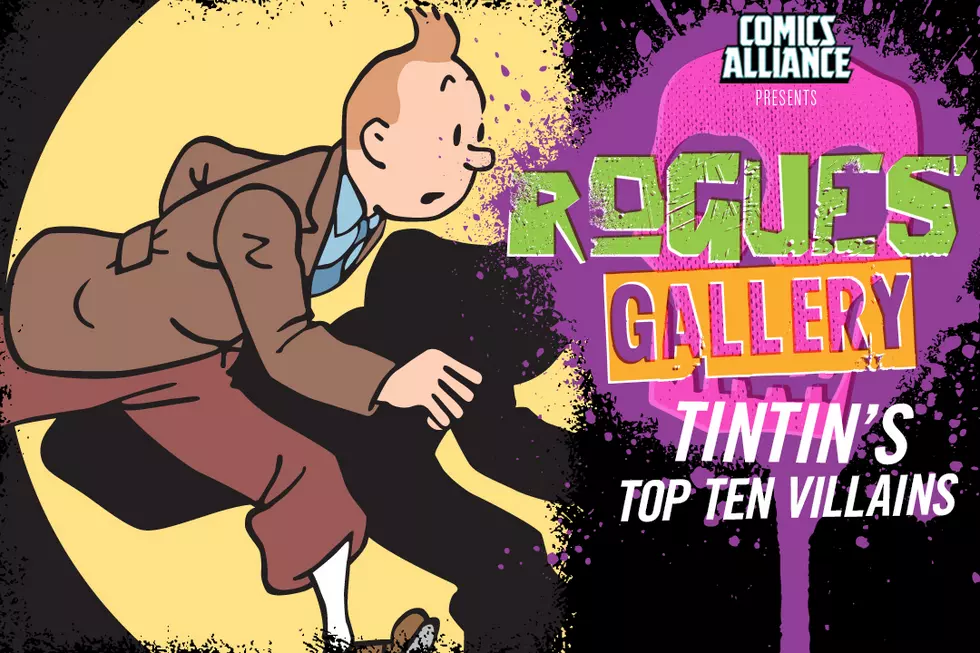
Happy Birthday to Tintin, Comics’ Problematic Fave
Although the first published drawing of intrepid teen reporter Tintin and his little white dog, Milou (known to English-speaking audiences as Snowy) appeared in Belgium's Le Petite Vingtième, the youth supplement to conservative Catholic newspaper Le Vingtième Siècle, on January 4, 1929, Tintin's creator, Georges Remi (better known by his pen name Hergé), insists that Tintin's birthday is January 10, on which day in 1929 the first installment of the first Tintin serial, Tintin au pays des Soviets (Tintin in the Land of the Soviets), was published --- so we choose this week to commemorate the anniversary of this significant moment in comics history.
Tintin is, without a doubt, one of the most towering efforts in the history of comics. Over the course of twenty-three albums, Hergé created a series of globe-trotting adventures full of colorful, memorable characters such as Captain Haddock, Professor Calculus, and the Thompson twins that ranged from the ocean floor to the surface of the moon. The books combined genres from espionage to mystery to political thriller to fantasy to science fiction to Western, all mixed with slapstick humor, to create some of the most charming, suspenseful, and exhilarating comics in history.
All of this says nothing of Hergé's widely imitated ligne claire style, which features clean line drawings of consistent line weight of expressive, animated figures over highly detailed, realistic backgrounds. Together, these qualities have made Tintin one of the best-selling and most highly revered comics series in history.
However, in recent years, Tintin has made headlines not for its exciting stories or bold, clear art. Instead, what has drawn the attention of audiences has been the more problematic aspects of Tintin's history, most notably the insensitive depiction of racial caricatures, especially in the earlier installments of the series. The worst of these can be found in the second album, Tintin in the Congo; the stereotypical, naïve portrayal of Congolese inhabitants has led to restricted availability of this volume in several countries, including the United States.
But while Tintin in the Congo is perhaps the most notable offender, it is hardly the only one. Many of the other volumes feature stereotypical and occasionally unsavory depictions of — among others — Arabs, Native Americans, Incas, and, in early versions of some adventures, Jewish people. Xenophobia is frequently at the heart of Tintin adventures; a foreigner of some sort is the villain in all but one or two of the Tintin albums.
This will hardly come as a surprise to readers familiar with comics of this era. Embarrassing and regrettable racial caricature is a blight across many comics from the art form's earliest days; it makes recommendation of some of the comics' greatest talents — Will Eisner, Winsor McCay, CC Beck, to name a few — impossible without conscientious caveats. Even the most mainstream comics featured horrendous racial stereotypes, especially during World War II, when Japanese caricatures were ubiquitous.
What sets Tintin apart from some of these other works is the series' continued relevance today. It may not be obvious to an American reader, but Tintin is a phenomenon worldwide. The twenty-three albums have sold over 200 million copies in over sixty different languages. The book has spawned magazines, toys, two television series, and multiple feature films, most recently Steven Spielberg's The Adventures of Tintin from 2011. Tintin has been the subject of stamps, parades, and museum exhibitions. Tintin is no small thing.
Part of what makes the distasteful elements of the earlier Tintin volumes more palatable is the noticeable shift in Hergé's view of the world as the years go on. The earliest Tintin stories are the product of a very young man, heavily influenced by a conservative Catholic upbringing and his editor/priest Father Norbert Wallez, who was an actual Fascist.
As Hergé grew older, his approach to people from other lands changed, thanks in part to the influence of his friendship with a Chinese art student named Zhang Chongren (sometimes spelled Chang Chong-Chen) and to the horror of World War II, as well as world travel and exposure to modern art and ideas. This personal growth led to Hergé revising and redacting much of his earlier work, saying, “my early works are books by a young Belgian filled with the prejudices and ideas of a Catholic […] they are not very intelligent, I know, and they do me no honor.”
Perhaps the surest sign of the sincerity of this change can be found in perhaps the finest of the Tintin volumes, Tintin in Tibet, in which the people of this foreign land are treated with dignity and respect, and in which Tintin is joined by his Chinese friend Chang, based on the real life man who first exposed Hergé to other cultures.
Did Hergé subsequently become the perfect, flawless cinnamon roll that Tumblr and the world is constantly searching for? No, of course not; even as his foreign characters became more and more humanized, he would still give in to some of the Orientalist exoticizing that is so much at the heart of pulpy adventure. However, watching an artist's personal moral evolution in parallel to his growth as a storyteller adds an extra layer of interest to an already fascinating series.
The question of whether a modern reader can approach a work like Tintin with a historical perspective and enjoy it for its unquestionable technical merit and craft, or whether the unsavory aspects of it overwhelm the positives enough that the book should be passed over, is a personal one that each reader must decide for themselves. But the skill and beauty of Hergé's work means that it is a question that will be asked for many years to come.
More From ComicsAlliance


![Rogues’ Gallery: Who Is Tintin’s Greatest Foe? [Kids’ Comics]](http://townsquare.media/site/622/files/2016/08/Tintin-Vote.jpg?w=980&q=75)
![‘Deepwater Prison’ Brings a French Tale of Aquatic Crime to the US [Preview]](http://townsquare.media/site/622/files/2016/03/Deepwater.png?w=980&q=75)





